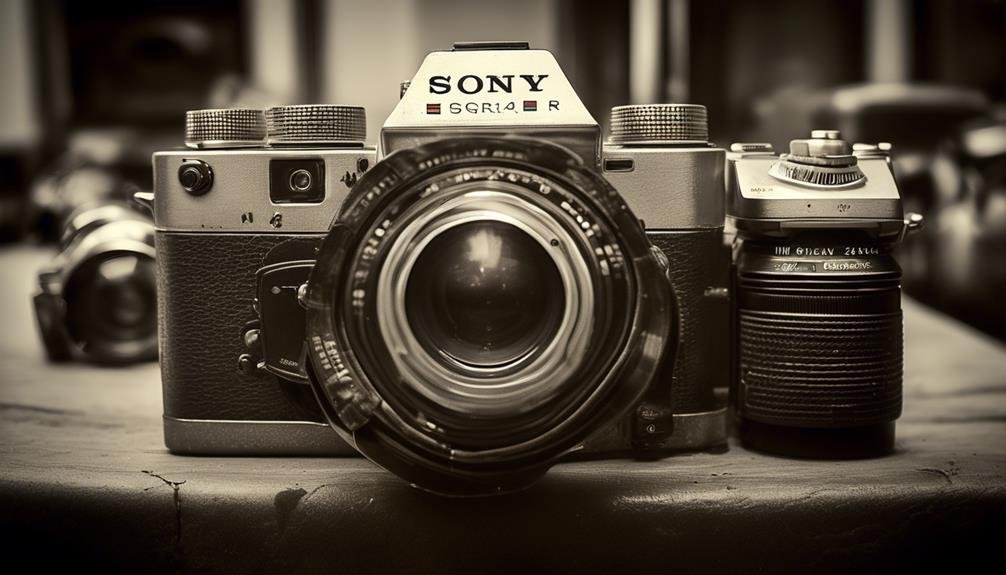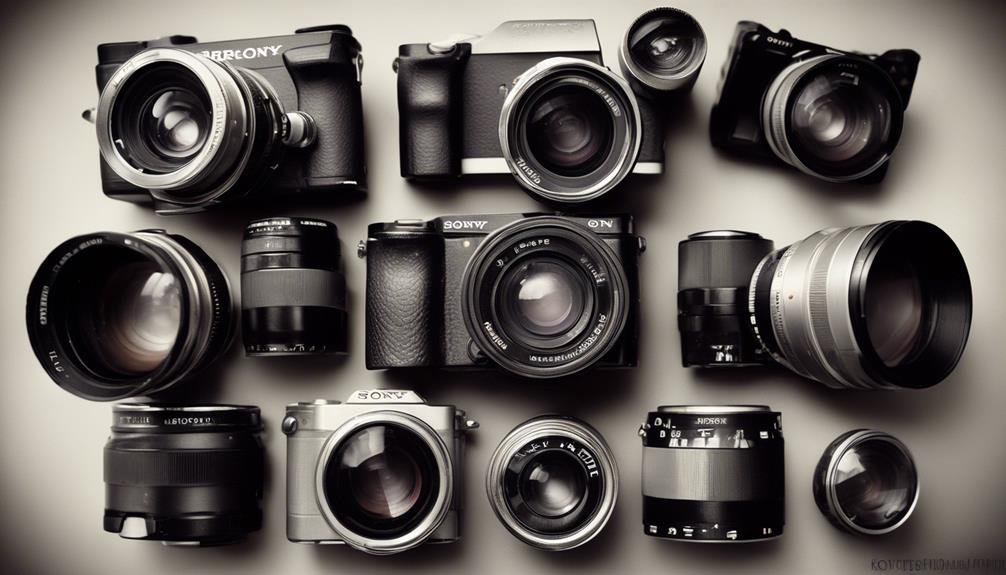
We've all experienced the frustration of finding a perfect lens, only to realize it's not compatible with our Sony mirrorless camera. The intricacies of lens compatibility stem from the specifics of the Sony E-mount lens system and the variations in lens mounts across different manufacturers. However, the reasons for this lack of universality go beyond just the physical connection; electronic communication compatibility, autofocus capabilities, and image stabilization also play crucial roles in determining whether a lens can seamlessly integrate with a Sony mirrorless camera. Understanding these complexities is essential for any photographer looking to maximize the potential of their Sony mirrorless system.
Sony E-Mount Lens System
The Sony E-Mount lens system offers a versatile range of lenses designed specifically for Sony's mirrorless cameras, providing photographers with a diverse selection of focal lengths and apertures to suit various shooting needs. This system is a key component of Sony's commitment to innovation, enabling photographers to push the boundaries of their creativity. One of the crucial aspects to consider when discussing the E-Mount system is lens compatibility. With a wide array of lenses available, compatibility ensures that photographers can seamlessly integrate different lenses into their workflow, allowing for greater flexibility and creative expression.
Moreover, the E-Mount system's compatibility extends beyond Sony's own lenses. Thanks to the availability of lens adaptors, photographers can utilize a vast selection of third-party lenses, opening up new possibilities and expanding their creative toolkit. This adaptability is a testament to Sony's dedication to providing a dynamic and inclusive ecosystem for photographers. By embracing lens adaptors, Sony empowers photographers to explore a wide range of lenses, further fueling their innovative spirit. The E-Mount system's emphasis on compatibility and adaptability underscores Sony's commitment to fostering a vibrant and expansive photography community.
Differences in Lens Mounts
When comparing different lens mounts, it is essential to understand the distinct physical and technical characteristics that define each system's compatibility with Sony mirrorless cameras. Lens compatibility with Sony mirrorless cameras is primarily determined by the lens mount design. The Sony E-mount, for instance, has a short flange distance, which impacts the physical compatibility of lenses. Understanding the differences in lens mounts involves analyzing factors such as flange distance, diameter, and electronic contacts. Mount adapters play a crucial role in bridging the gap between various lens mounts and Sony mirrorless cameras. These adapters enable the attachment of lenses with different mounts to Sony cameras, expanding the range of compatible lenses. However, it's important to note that while mount adapters provide a degree of compatibility, they may not fully support all functions of the attached lens, such as autofocus or electronic aperture control. Innovations in mount adapter technology continue to address these limitations, aiming to provide seamless integration between different lens mounts and Sony mirrorless cameras. As the industry evolves, understanding the differences in lens mounts and the role of mount adapters becomes increasingly important for photographers seeking to maximize the potential of their Sony mirrorless systems.
Electronic Communication Compatibility

Understanding the electronic communication compatibility between different lens mounts and Sony mirrorless cameras is essential for maximizing the functionality and performance of attached lenses. When a lens is mounted on a Sony mirrorless camera, electronic contacts on both the lens and the camera body facilitate communication for transmitting data such as focal length, aperture, and image stabilization settings. However, not all lenses are fully compatible due to variations in electronic communication protocols and lens firmware.
The electronic contacts on the lens and the camera body allow for seamless integration and communication, enabling features such as autofocus, aperture control, and image stabilization to function properly. Compatibility issues often arise when older lenses with outdated firmware are used on newer Sony mirrorless cameras, leading to limited or non-functional electronic communication. This is because the camera's firmware may not fully support the electronic protocols of the older lenses.
To address electronic communication compatibility challenges, manufacturers often release firmware updates for both lenses and camera bodies. These updates ensure that electronic communication protocols are aligned, allowing for full compatibility and optimal performance. Additionally, third-party adapters and firmware hacks have been developed to enhance electronic communication compatibility between non-native lenses and Sony mirrorless cameras. Understanding these electronic communication intricacies is crucial for photographers and videographers seeking to utilize a wide range of lenses with their Sony mirrorless systems.
Autofocus and Image Stabilization
Maximizing lens compatibility with Sony mirrorless cameras necessitates a thorough grasp of autofocus and image stabilization functionalities. These are critical factors that determine whether a lens is fully compatible with a Sony mirrorless camera. Understanding these functionalities is essential for photographers and videographers seeking optimal performance from their equipment. Here's a breakdown of key points:
- Autofocus Technology: Sony mirrorless cameras utilize advanced autofocus systems, such as phase-detection and contrast-detection, to achieve fast and accurate focus. Compatible lenses must support these autofocus technologies to ensure seamless integration with the camera system.
- Image Stabilization: Sony mirrorless cameras often feature in-body image stabilization (IBIS) which compensates for camera shake. For complete lens compatibility, it's crucial to consider whether the lens incorporates optical stabilization or if it can effectively communicate with the camera's IBIS system.
- Compatibility Firmware Updates: Manufacturers frequently release firmware updates to enhance lens compatibility with Sony mirrorless cameras. Checking for and applying these updates can resolve compatibility issues and improve overall performance.
Understanding the intricacies of autofocus and image stabilization is fundamental to achieving full lens compatibility with Sony mirrorless cameras, ensuring photographers and videographers can harness the full potential of their equipment.
Third-Party Lens Considerations

We will explore the considerations and implications associated with utilizing third-party lenses with Sony mirrorless cameras. When considering third-party lenses, it's essential to assess lens compatibility and brand reputation. Third-party lenses can offer a more budget-friendly option compared to original manufacturer lenses, but they may present challenges in terms of compatibility and performance.
| Consideration | Implications |
|---|---|
| Lens Compatibility | Third-party lenses may not fully support all autofocus and image stabilization features of Sony mirrorless cameras. It's crucial to research and ensure the lens is compatible with your specific camera model. |
| Brand Reputation | Some third-party manufacturers have built a strong reputation for producing high-quality lenses that rival original manufacturer offerings. However, others may have inconsistencies in quality and performance. It's important to consider the reputation of the brand before investing in a third-party lens. |
When opting for third-party lenses, it's imperative to carefully evaluate the trade-offs between cost savings and potential compromises in compatibility and performance. Additionally, researching the brand reputation can provide insights into the overall quality and reliability of the third-party lenses, helping to make an informed decision.
Frequently Asked Questions
Can I Use Canon or Nikon Lenses on a Sony Mirrorless Camera With an Adapter?
Yes, you can use Canon or Nikon lenses on a Sony mirrorless camera with an adapter. Using adapters expands lens compatibility, providing access to a wider range of lenses for creative and technical flexibility.
What Are the Potential Drawbacks of Using Third-Party Lenses With a Sony Mirrorless Camera?
Potential drawbacks of using third-party lenses with a Sony mirrorless camera include compatibility concerns and potential loss of autofocus and image stabilization functionality. Are these trade-offs worth it for the cost savings and unique optical qualities?
How Do I Know if a Specific Lens Will Be Compatible With My Sony Mirrorless Camera's Autofocus and Image Stabilization Features?
We ensure lens compatibility by researching autofocus performance and image stabilization features. We consider the camera's firmware and lens specifications to verify compatibility. Understanding the technical requirements is crucial for ensuring optimal performance and innovation.
Are There Any Workarounds or Hacks to Make Non-Compatible Lenses Work With a Sony Mirrorless Camera?
Oh, we've scouted every corner of the internet for workarounds and hacks to make non-compatible lenses work with our Sony mirrorless. Adapters are our lifelines, but sometimes it's a game of trial and error.
Will Using a Non-Compatible Lens With a Sony Mirrorless Camera Affect the Overall Image Quality or Performance of the Camera?
Using a non-compatible lens with a Sony mirrorless camera can significantly impact photography. Lens compatibility affects image quality and camera performance. It's crucial to ensure that the lens is fully compatible for optimal results.
